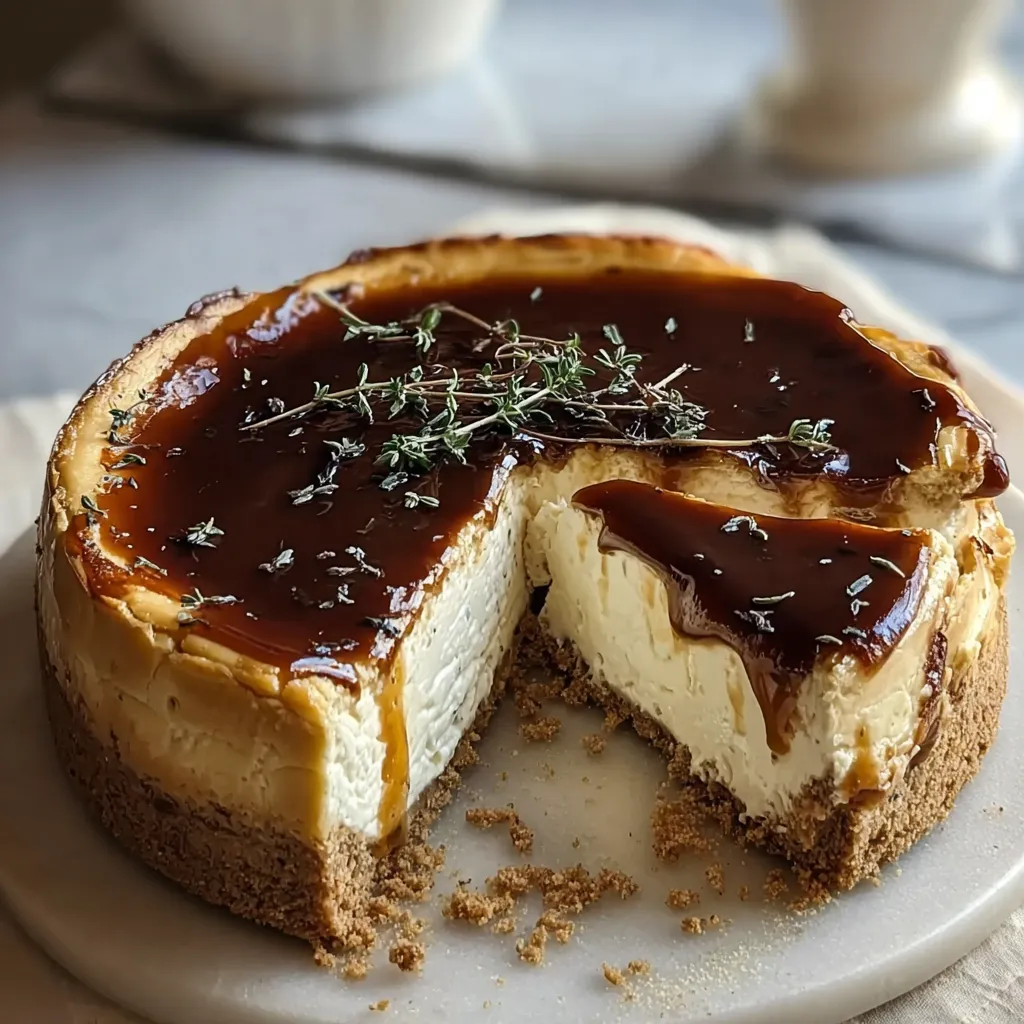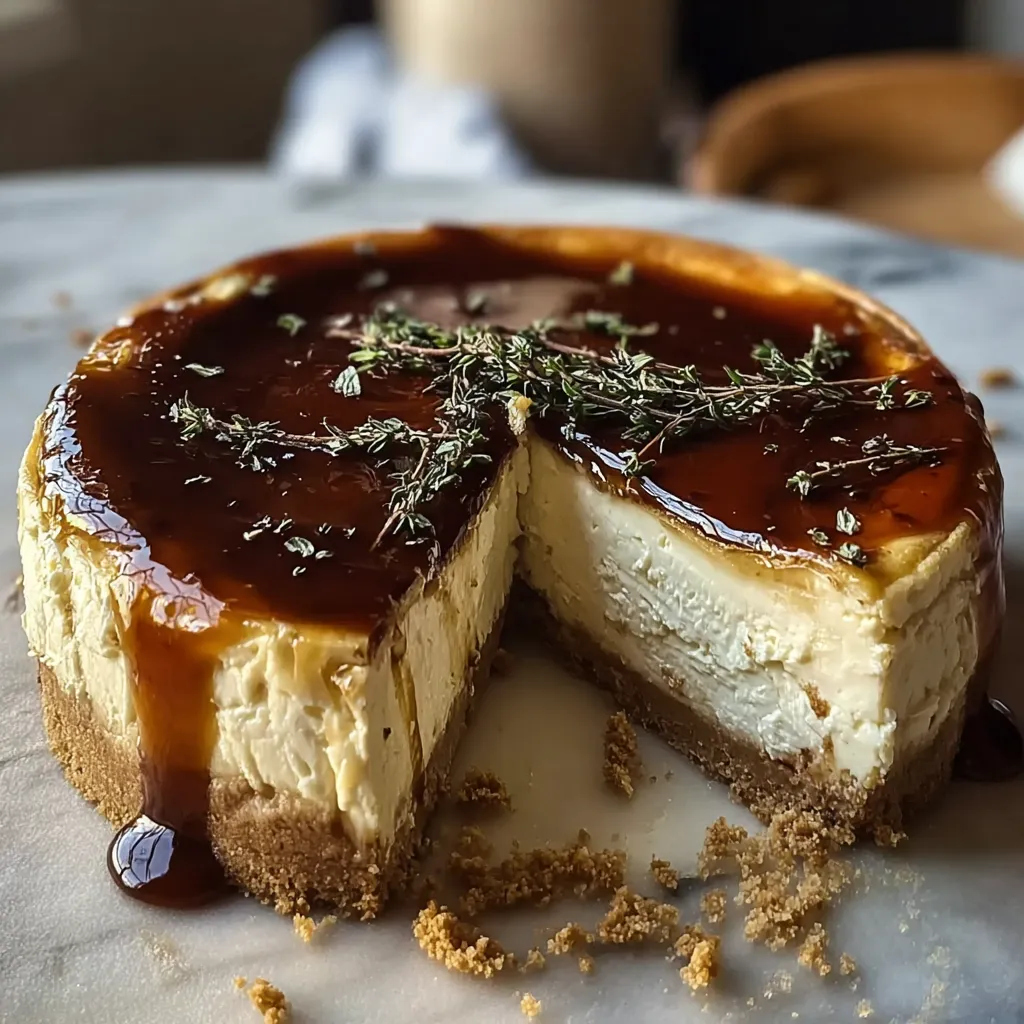 Save
Save
This savory-sweet feta cheesecake offers an unexpected twist on traditional dessert cheesecakes by blending tangy feta with smooth cream cheese, aromatic herbs, and a touch of honey—all nestled on a buttery graham cracker crust.
I first created this cheesecake for a Mediterranean-themed dinner party, and it disappeared faster than any other dish on the table. Now it's become my signature contribution to brunches and holiday gatherings.
Ingredients
- Graham cracker crumbs provide the perfect buttery base with a slight sweetness that complements the savory filling
- Cream cheese creates that classic cheesecake texture everyone loves look for full-fat for the creamiest results
- Feta cheese adds the distinctive tangy flavor that makes this cheesecake unique choose a good quality Greek feta for the best flavor
- Sour cream brings extra creaminess and a slight tang to balance the richness
- Eggs bind everything together while adding richness
- Honey adds just enough sweetness without overwhelming the savory elements select a mild variety like clover
- Lemon zest brightens all the flavors with its citrus notes use organic lemons if possible
- Fresh thyme infuses the cheesecake with aromatic herbal notes that pair perfectly with the feta
- Salt and pepper enhance all the flavors use freshly ground pepper for the best flavor
Step-by-Step Instructions
- Prepare the Crust
- Preheat your oven to exactly 325°F for that perfect baking environment. In a medium bowl, thoroughly combine the graham cracker crumbs with melted butter until every crumb is moistened. The mixture should hold together when pressed between your fingers. Transfer this mixture to a 9-inch springform pan and press firmly across the bottom and about 1 inch up the sides using the flat bottom of a measuring cup to create an even compact layer.
- Create the Filling
- In a large mixing bowl, add your softened cream cheese and crumbled feta. Beat on medium speed for 3-4 minutes until completely smooth with no lumps remaining. The texture should be light and fluffy. Add the sour cream, honey, lemon zest, chopped thyme, and a pinch each of salt and pepper. Mix until all ingredients are fully incorporated, scraping down the sides of the bowl frequently to ensure everything blends evenly.
- Incorporate the Eggs
- Reduce your mixer speed to low. Add one egg and mix just until incorporated about 15 seconds. Repeat with the remaining eggs, adding them one at a time. Overmixing at this stage can incorporate too much air and cause the cheesecake to crack, so mix just until each egg disappears into the batter. The mixture should look silky and pourable.
- Bake to Perfection
- Pour your filling into the prepared crust, smoothing the top with a spatula. Gently tap the pan on the counter a few times to release any trapped air bubbles. Place in the preheated oven and bake for 45-50 minutes. The cheesecake is done when the edges are set but the center still has a slight jiggle when you gently shake the pan. Avoid opening the oven door during baking as temperature fluctuations can cause cracking.
- Cooling and Chilling
- Turn off the oven and crack open the door, leaving the cheesecake inside for about 30 minutes. This gradual cooling helps prevent the surface from cracking. Remove from the oven and run a thin knife around the edge of the pan to release the cheesecake from the sides. Cool completely at room temperature, then cover and refrigerate for at least 4 hours or overnight. The flavors develop and meld beautifully during this chilling time.
 Save
Save
The first time I served this cheesecake at a family gathering, my uncle who claims to hate both cheesecake and feta went back for seconds and then asked for the recipe. That moment confirmed for me that unexpected flavor combinations can create the most memorable food experiences.
Serving Suggestions
This feta cheesecake shines as part of a Mediterranean meze spread alongside olives, roasted peppers, and fresh bread. For a more substantial offering, pair slices with a simple arugula salad dressed with lemon and olive oil. The peppery greens cut through the richness of the cheesecake beautifully. I often drizzle each slice with an extra touch of honey and sprinkle with fresh thyme leaves just before serving to enhance both the visual appeal and flavor profile.
Customization Options
Feel free to experiment with the herbs in this recipe based on what you have available. Rosemary offers a more robust flavor profile, while dill creates a brighter, more distinctly Mediterranean character. For a more savory version, reduce the honey to 1 tablespoon and fold in 2-3 cloves of roasted garlic and a handful of sun-dried tomatoes. Alternatively, for a sweeter approach, increase the honey to 3 tablespoons and add a teaspoon of vanilla extract to the batter.
Storage Tips
The cheesecake will keep beautifully in the refrigerator for up to 4 days when stored in an airtight container or covered tightly with plastic wrap. If you want to freeze leftovers, wrap individual slices in plastic wrap and then aluminum foil before freezing for up to 2 months. Thaw overnight in the refrigerator before serving. Let the cheesecake come to room temperature for about 20 minutes before serving for the best flavor and texture experience.
The Science Behind the Recipe
The secret to this cheesecake's unique texture lies in the combination of different dairy products. The cream cheese provides structure and smoothness, while the feta brings both tanginess and a slightly crumblier texture. The eggs act as a binding agent, creating that signature cheesecake consistency when baked. The slow cooling process is crucial as it prevents the dramatic temperature change that can cause the cheesecake to contract too quickly and crack on top.
 Save
Save
Recipe FAQs
- → Can I make this feta cheesecake ahead of time?
Yes, this cheesecake actually benefits from being made ahead. For best results, prepare it 1-2 days before serving and keep refrigerated. The flavors will develop and meld beautifully during this time, and it makes entertaining stress-free.
- → What can I serve with feta cheesecake?
For a complete appetizer spread, serve with roasted olives, a small honey drizzle, fresh fruits like figs or grapes, and crusty bread. As a brunch dish, pair with a simple green salad dressed with lemon vinaigrette for a delightful contrast.
- → Can I freeze feta cheesecake?
Yes, you can freeze it for up to 1 month. Cool completely, then wrap tightly in plastic wrap followed by foil. Thaw overnight in the refrigerator before serving. The texture may change slightly but will still be delicious.
- → What herbs can I substitute for thyme?
Fresh rosemary, oregano, or basil all work beautifully with the feta. For a different flavor profile, try dill or mint, which pair exceptionally well with Mediterranean flavors. Use about the same amount as called for with the thyme.
- → How do I know when the cheesecake is properly baked?
The cheesecake should be set around the edges but still have a slight jiggle in the center when gently shaken. The top should not be brown or cracked. It will continue to set as it cools. Avoid opening the oven door frequently while baking.
- → Can I make this without a springform pan?
While a springform pan is ideal, you can use a deep pie dish. Line it with parchment paper with overhang to help lift the cheesecake out. The presentation won't be as clean, but the flavor will be identical.
